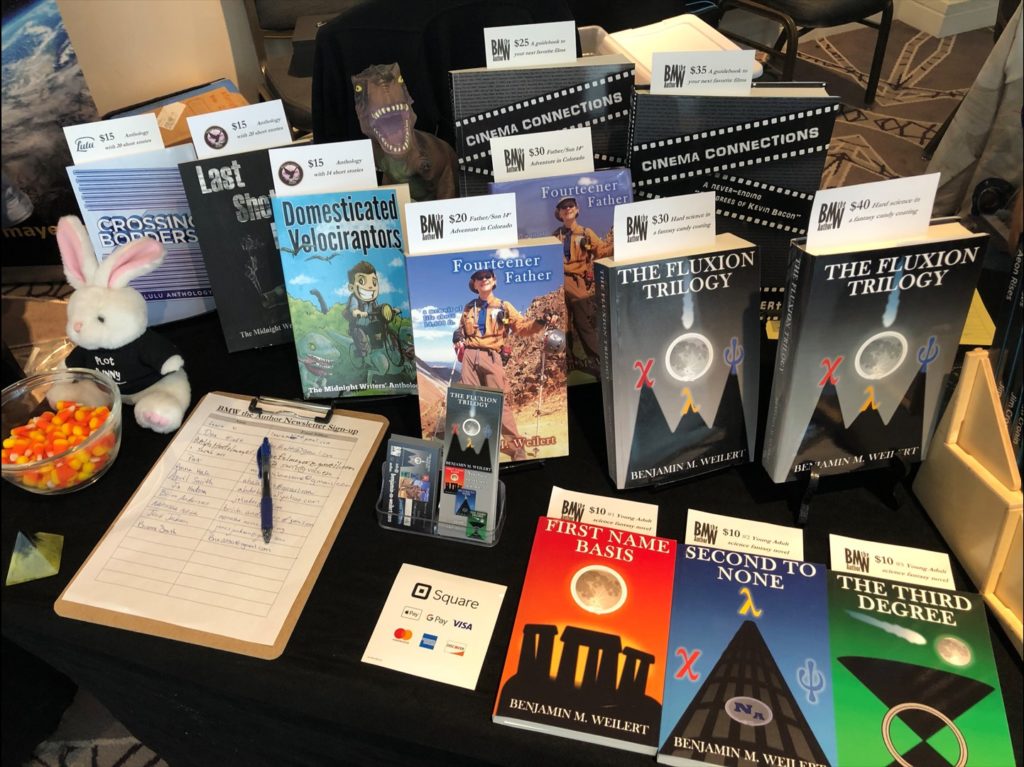It’s often been said that writing is a solitary profession. The problem is that—if you want to sell your books—you need to interact with other people. Selling online can be a challenge when there are so many options easily available and selling in brick-and-mortar stores has its own limitations and constraints. As an independent, self-published author, one of the best ways I’ve found to get my books into the hands of potential readers is by attending conventions as a vendor.
There are lots of different conventions (or “cons” for short) out there. For some examples, check out my Events Page to see a history of all the cons I’ve attended as a vendor. Since most of my books fit in the science fiction and fantasy genres, I have found sci-fi conventions to be great places to set up shop. That doesn’t mean there aren’t cons for other genres where you can find readers who would want to read your books. In fact, I’m fairly certain there are tons of romance book conventions for people who read that genre. This is why conventions are a great place to sell books: your audience comes to you!
Personal interaction with customers is key.
I’ve found that I get a lot of good sales by paying for a vendor table at these conventions. Part of the reason for this is that I can tailor my interactions with people. By talking with potential customers, I can learn what they like to read and direct them toward the book that would most align with their interests. Of course, having a quick pitch for each of your books makes this interaction easier. If you don’t know what your books are about in a single catchy sentence, it can be more challenging to close a sale, but not impossible.
Many vendors at these conventions benefit from excellent cover art to catch the eyes of the customers who pass by their tables. Knowing the audience for your books is key to ensuring you get the right covers made to attract them and get them to stop and pick up a copy. It’s also fun to try different tactics with pitches and book displays to see what works and what doesn’t (scientifically speaking, this is known as “A-B Testing.”). This A-B Testing can be invaluable for you to better understand your customers and apply what you learned in your online presence as well. And if everything clicks, nothing feels better than discussing your book with someone who is legitimately interested in your work. The enthusiasm of readers often keeps me coming back to conventions to sell time and time again.
It’s not easy, but it’s rewarding.

As an introvert (which many authors are), selling books in person can be terrifying. It can also be demoralizing when you get a lot of rejections from people passing by who won’t even give you the time of day. All I can say is that it gets easier with time and experience. Additionally, some conventions might not work for you and it’s important to identify that before committing to coming back for the next year. Perhaps the con is too small, or it really isn’t the right audience. Often, it doesn’t hurt to get out there and try. Worst-case scenario, you’re down the cost of the table and a weekend of time.
Costs can sometimes add up quickly when selling books at a convention. Each con is different in how they price their attendance packages. I’ve been to some conventions where a vendor table is $25, which includes a ticket to attend the con for the weekend. Then there are big comic conventions (Comic Cons) where the tables are $350 and a ticket to attend for the weekend is an additional $50. The benefits of small conventions come in the event’s intimacy—there’s often less to do, which gives people enough time to peruse the vendor tables at their leisure. Bigger conventions, however, benefit from the sheer volume of customers passing by your table. If your conversion rate is 1% for every person who passes by, then you could potentially sell 100 books at a con with 10,000 attendees, as compared to 1 sale at a convention of 100.

If you’re planning on getting a vendor table at a convention, there are a few things you should bring with you. Here’s a brief listing that should be helpful…
- Physical copies of your books.
- Cash box with change.
- Square/PayPal/Venmo account and credit card reader.
- Boxes to move/transport your books from your car (ideally big enough to store books with spines upright).
- Cart or collapsable hand truck to make moving boxes easier.
- Promotional materials (bookmarks, postcards, tchotchkes, etc.) for your books.
- Business cards so customers can find you online.
- A sign-up sheet for your newsletter (optional).
- Display rack or stands for your books (optional).
- Banner or table runner with your branding on it (optional).
A lot of these things are obviously reusable from convention to convention, and you don’t need everything right from the start. Much of my equipment I picked up over the years as it became obvious I needed it. I will also note that Vistaprint sometimes has sales on business cards, banners, postcards, and other promotional material you can use to attract customers to your table. Ultimately, do what works for you. Of course, selling books at conventions is only half of the reason you, as an author, should attend them. Next month, I’ll cover the other benefit of attending cons: networking.
Have you ever attended a convention?
If you’re passing by a table with books, what’s the first thing you see?
What would compel you to buy a book at a convention?
